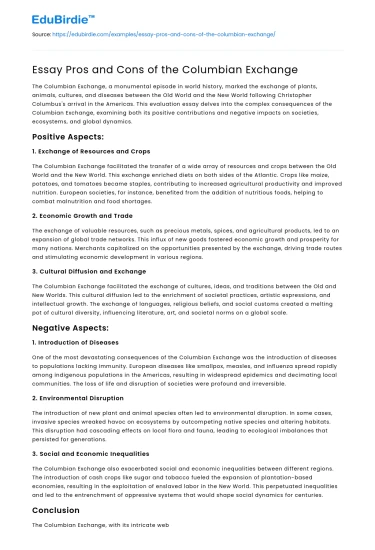The Columbian Exchange, a monumental episode in world history, marked the exchange of plants, animals, cultures, and diseases between the Old World and the New World following Christopher Columbus's arrival in the Americas. This evaluation essay delves into the complex consequences of the Columbian Exchange, examining both its positive contributions and negative impacts on societies, ecosystems, and global dynamics.
Positive Aspects:
1. Exchange of Resources and Crops
The Columbian Exchange facilitated the transfer of a wide array of resources and crops between the Old World and the New World. This exchange enriched diets on both sides of the Atlantic. Crops like maize, potatoes, and tomatoes became staples, contributing to increased agricultural productivity and improved nutrition. European societies, for instance, benefited from the addition of nutritious foods, helping to combat malnutrition and food shortages.
Save your time!
We can take care of your essay
- Proper editing and formatting
- Free revision, title page, and bibliography
- Flexible prices and money-back guarantee
2. Economic Growth and Trade
The exchange of valuable resources, such as precious metals, spices, and agricultural products, led to an expansion of global trade networks. This influx of new goods fostered economic growth and prosperity for many nations. Merchants capitalized on the opportunities presented by the exchange, driving trade routes and stimulating economic development in various regions.
3. Cultural Diffusion and Exchange
The Columbian Exchange facilitated the exchange of cultures, ideas, and traditions between the Old and New Worlds. This cultural diffusion led to the enrichment of societal practices, artistic expressions, and intellectual growth. The exchange of languages, religious beliefs, and social customs created a melting pot of cultural diversity, influencing literature, art, and societal norms on a global scale.
Negative Aspects:
1. Introduction of Diseases
One of the most devastating consequences of the Columbian Exchange was the introduction of diseases to populations lacking immunity. European diseases like smallpox, measles, and influenza spread rapidly among indigenous populations in the Americas, resulting in widespread epidemics and decimating local communities. The loss of life and disruption of societies were profound and irreversible.
2. Environmental Disruption
The introduction of new plant and animal species often led to environmental disruption. In some cases, invasive species wreaked havoc on ecosystems by outcompeting native species and altering habitats. This disruption had cascading effects on local flora and fauna, leading to ecological imbalances that persisted for generations.
3. Social and Economic Inequalities
The Columbian Exchange also exacerbated social and economic inequalities between different regions. The introduction of cash crops like sugar and tobacco fueled the expansion of plantation-based economies, resulting in the exploitation of enslaved labor in the New World. This perpetuated inequalities and led to the entrenchment of oppressive systems that would shape social dynamics for centuries.
Conclusion
The Columbian Exchange, with its intricate web of positive contributions and negative consequences, altered the course of history and transformed societies, economies, and ecosystems. The exchange of resources, crops, and cultures enriched societies and facilitated economic growth and intellectual exchange. However, the introduction of diseases, environmental disruption, and the perpetuation of social inequalities cast a shadow over these gains.
As we evaluate the Columbian Exchange, it is essential to recognize its multifaceted impact and complexities. It highlights the interconnectedness of human societies and the delicate balance between progress and unintended consequences. The exchange serves as a reminder that human actions, even with the best intentions, can lead to far-reaching effects that shape the course of history.
By understanding the pros and cons of the Columbian Exchange, we gain insight into the intricate relationships between societies and ecosystems. It compels us to consider the far-reaching consequences of our actions in an increasingly interconnected world. Ultimately, the legacy of the Columbian Exchange challenges us to approach global interactions with a sense of responsibility, awareness, and a commitment to shaping a more equitable and sustainable future.






 Stuck on your essay?
Stuck on your essay?

